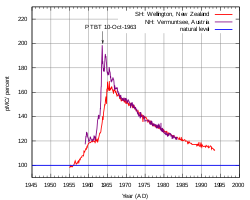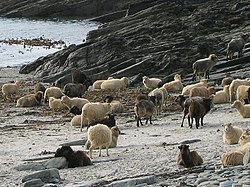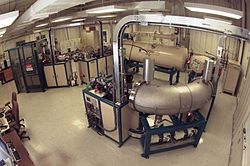Radiocarbon dating

Radiocarbon dating, also known as the C14 dating method, is a way of telling how old an object is. It is a type of radiometric dating.
The method uses the radioactive isotope carbon-14. Most organic matter contains carbon. Carbon has different isotopes, which are usually not radioactive. 14C is the radioactive one, its half-life (time it takes to reduce its radioactivity by half) is about 5,730 years. This makes it possible to tell the age of substances that contain carbon. The method works to about 60,000 years old. Dates obtained are usually written as before present ('present' is 1950).
Plants take up atmospheric carbon dioxide by photosynthesis, and are eaten by animals, so every living thing is constantly exchanging carbon-14 with its environment as long as it lives. Once it dies, however, this exchange stops.
In 1958 Hessel de Vries showed that the concentration of carbon-14 in the atmosphere varies with time and locality. The relatively short-lived 14C is constantly renewed by cosmic ray bombardment on atmospheric nitrogen. Since the bombardment is slightly variable, and for other reasons, the 14C taken into organic matter is also slightly variable. That leads to errors in the chronology. However, under about 20,000 years the results can be compared with dendrochronology, based on tree rings. For the most accurate work, variations are compensated by means of calibration curves.
The method was developed by Willard Libby and his colleagues at the University of Chicago in 1949. In 1960, he was awarded the Nobel Prize in Chemistry for this work. He first demonstrated the accuracy of radiocarbon dating by accurately estimating the age of wood from an ancient Egyptian royal barge of which the age was known from historical documents.[4][5]
Radiocarbon Dating Media
Radiocarbon dating helped verify the authenticity of the Dead Sea scrolls.
Simplified version of the carbon exchange reservoir, showing proportions of carbon and relative activity of the 14
C in each reservoir[note 1]Atmospheric 14
C for the northern and southern hemispheres, showing percentage excess above pre-bomb levels. The Partial Test Ban Treaty went into effect on 10 October 1963.North Ronaldsay sheep on the beach in North Ronaldsay. In the winter, these sheep eat seaweed, which has a higher Template:Delta content than grass; samples from these sheep have a Template:Delta value of about −13‰, which is much higher than for sheep that feed on grasses.
Other websites
- Radiocarbon - The main international journal of record for research articles and date lists relevant to 14C Archived 2007-05-31 at the Wayback Machine
- C14dating.com - General information on Radiocarbon dating
- NOSAMS: National Ocean Sciences Accelerator Mass Spectrometry Facility at the Woods Hole Oceanographic Institution Archived 2007-07-05 at the Wayback Machine
- Discussion of calibration Archived 2007-10-14 at the Wayback Machine
- Several calibration programs can be found at www.radiocarbon.org Archived 2016-01-26 at the Wayback Machine
- CalPal Online (Cologne Radiocarbon Calibration & Paleoclimate Research Package)
- OxCal program (Oxford Calibration) Archived 2005-10-18 at the Wayback Machine
- Fairbanks' Radiocarbon Calibration program (for prior to 12400 BP) Archived 2011-08-25 at the Wayback Machine
- Further basic information on radiocarbon dating (PDF)
References
- ↑ "Atmospheric δ14C record from Wellington". Carbon Dioxide Information Analysis Center. Archived from the original on 1 February 2014. Retrieved 1 May 2008.
- ↑ "δ14Atmospheric δ14C record from Vermunt". Carbon Dioxide Information Analysis Center. Archived from the original on 23 September 2008. Retrieved 1 May 2008.
- ↑ "Radiocarbon dating". Utrecht University. Retrieved 1 May 2008.
- ↑ Arnold, J. R.; Libby, W. F. (1949). "Age determinations by radiocarbon content: checks with samples of known age". Science. 110 (2869): 678–680. Bibcode:1949Sci...110..678A. doi:10.1126/science.110.2869.678. PMID 15407879.
- ↑ "Willard Frank Libby". Archived from the original on 2010-11-29. Retrieved 2009-12-11.
Cite error: There are <ref> tags on this page, but the references will not show without a {{Reflist|group=note}} template or a <references group="note"/> tag.









